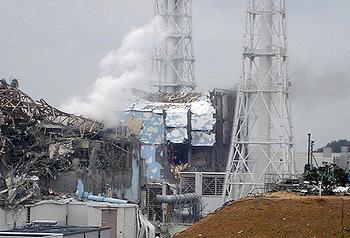
TOKYO, Japan, March 11, 2016 (ENS) – “The environmental impacts of the Fukushima Daiichi nuclear disaster will last decades to centuries, due to man-made, long-lived radioactive elements are absorbed into the living tissues of plants and animals and being recycled through food webs, and carried downstream to the Pacific Ocean by typhoons, snowmelt, and flooding,” writes Greenpeace Japan in a new report issued ahead of the fifth anniversary of the world’s worst nuclear disaster since Chernobyl.
Japan’s Prime Minister Shinzo Abe said Thursday, “Reactor decommissioning represents a long road ahead that will last upwards of 40 years.”

Yet Prime Minister Abe Thursday revealed the government’s plans to bring displaced residents back to the area within the year, and to develop tourist attractions based on the area’s natural values to provide income to residents in the future.
Five years ago today a triple disaster struck Japan when a massive 9.0 earthquake rattled the coast of Japan’s main island of Honshu, setting off a giant tsunami wave that flooded the Fukushima Daiichi nuclear power plant, owned and operated by the Tokyo Electric Power Company, TEPCO.
Three of the power plant’s six nuclear reactors exploded due to hydrogen gas that built up within their outer containment buildings after cooling system failures resulting from the loss of electrical power at the flooded power plant.
The earthquake and tsunami killed 15,894 people. Another 6,152 were injured and roughly 2,500 others are still officially listed as missing. The tsunami resulted in over 340,000 displaced people in the Tōhoku region.
Residents of the Tohoku region within a 20 kilometer (12 mile) radius of the Fukushima Daiichi Nuclear Power Plant and a 10 km (6.2 mile) radius of the nearby Fukushima Daini Nuclear Power Plant were evacuated.
Since March 2011, Greenpeace has conducted 25 radiological investigations in Fukushima prefecture. In 2015, the NGO focused on the contamination of forested mountains in Iitate district, northwest of the Fukushima Daiichi nuclear power plant.
That research is summarized in the new report from Greenpeace Japan, “Radiation Reloaded: Ecological Impacts of the Fukushima Daiichi Nuclear Accident 5 Years Later.”
Greenpeace and independent research both have shown the movement of radioactivity from contaminated mountain watersheds to coastal ecosystems. There are “vast expanses of Fukushima’s radioactive forests, which cannot be decontaminated,” writes Greenpeace.

The Abukuma, one of Japan’s largest rivers, which flows through Fukushima prefecture, is projected to discharge two forms of radioactive cesium in the 100 years after the accident, Greenpeace researchers project.
Greenpeace shows that radiation levels still remain too high for people to safely return to areas where evacuation orders have either been lifted or soon will be lifted.
“This is largely a problem of politics being put before public health. Rather than focusing these efforts where people are currently living, which still have hot spots and where such work could be most successful in reducing human exposures, much of the effort has been focused on attempting to decontaminate the evacuated towns and little 20 meter strips of forests along roads where no one lives,” the Greenpeace report states.
The report is based on a large body of independent scientific research in impacted areas in the Fukushima region, as well as investigations by Greenpeace radiation specialists over the past five years.

The report “exposes deeply flawed assumptions” by the International Atomic Energy Agency and the government of Prime Minister Abe “in terms of both decontamination and ecosystem risks,” Greenpeace states.
At the five-year memorial ceremony in Tokyo on Friday, Prime Minister Abe pledged that “the government will exert its unified efforts to build a strong and resilient nation that is resistant to disasters.”
“Many people are still leading uncomfortable lives in the affected areas. There are many who cannot return to their beloved homes because of the accident at the nuclear power plant,” acknowledged Abe.
“Every time I visit the affected areas, I fully sense that the disaster is continuing. And yet, step by step, the reconstruction is making steady progress,” he said. “Revitalization of the livelihoods of the residents is similarly gathering pace and becoming fully fledged alongside the construction of new housing.”
“We commit ourselves to such tasks as providing care for their minds and bodies, forming new local communities and supporting industrial development of the affected areas, so that reconstruction leads to the attractive revitalization of the region,” said the prime minister.
At a joint meeting of the Reconstruction Promotion Council and the Nuclear Emergency Response Headquarters at the Prime Minister’s Office on Thursday, Abe said that measures to address water pollution and the decommissioning of the Fukushima Daiichi are making “solid progress.”

“Reconstruction will not end with simple recovery,” Abe said. “Rather, it must be something tangible that paves the way for the future of Tohoku.”
The area’s future will be based on tourism, promised Abe. “We will further refine the resources of each region, which offer attractions such as nature, history, food and hot springs, among others, and make the region an appealing destination for people from around the world.”
But that plan depends upon the recovery of the Tohoku ecosystem.
Greenpeace reports that damage to the area is permanent, writing, “The victims of the nuclear disaster are not only the citizens of Fukushima and other impacted areas, but also the ecosystems – the plants and animals that comprise them – that have been irreversibly damaged by this man-made catastrophe.”
Copyright Environment News Service (ENS) 2016. All rights reserved.
© 2016, Environment News Service. All rights reserved. Content may be quoted only with proper attribution and a direct link to the original article. Full reproduction is prohibited.
